By Br. Gregory Stewart
Los Angeles, California, USA
” A Traveler in Freemasonry”

The Saint’s – John the Baptist and John the Evangelist, appear to Freemasons in several places in our catechisms.
Their proximity and use in our rituals have been questioned for many years as to their use and placement. Looked at together, Saint John the Baptist and St. John the Evangelist serve to represent the balance in Masonry between zeal for the fraternity and learned equilibrium. The Saints John, stand in perfect parallel harmony representing that balance.
From a historical approach, The Saint John’s festival is said to be a widely celebrated Masonic holiday.
Traditionally June 24th (or the summer Solstice) is taken to be John the Baptist’s day, which is celebrated in many cultures around the world. According to McCoy’s Masonic Dictionary, the Festival of St. John in summer is a duty of every Mason to participate in, and should serve to be a renewal and strengthening of fraternal ties and a celebration of Masonry from “olden-times”. It functions as a connection between the past and the future.

The festival, to non-Masons, has been called the “Setting of the Watch”, where ceremonial bonfires were lit after sunset. Tradition says that men, women, and children would jump through the fires for luck. Across Europe, this holiday is celebrated in many ways. With oak wreath crowns, wild flowers and birch branches. Families would feast and celebrate in union. The meanings of these ancient traditions are lost today on our society, but the link was made at some point to John the Baptist. The On-line Catholic Encyclopedia points to the birth of John the Baptist as 6 months before Christ, placing him on the summer solstice. It is thought that these festivals have been linked in character and content with the birth of John the Baptist.
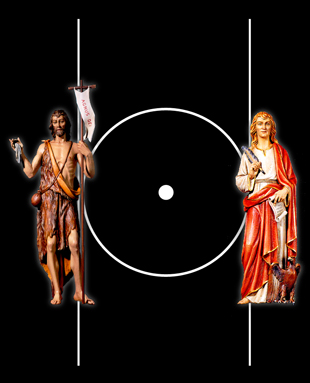
From the Masonic perspective we are given the balanced dualism of John the Baptist on one side and John the Evangelist on the other. Represented together this way represent the balance of passionate zeal with and learned knowledge of faith forming a space to reflect on to and channel our passion as well as our education/knowledge. Individually strong, together they stand as a harnessed focus of zeal and knowledge. This counterpoint is not just necessary to Freemasonry but can be applied to all areas of life. Taken as an abstract compilation of symbols, together they represent a well-balanced path towards enlightenment.
The two dualistic figures as one, the Holy Saints John, balance each other in the Masonic year, but also in other areas too. One unique aspect that I found is in the application of the Alchemical symbols of fire and water. Alchemy has long been thought of as an early component of Freemasonry and using the alchemical symbols here may help the representations of the Saint John’s look more familiar. Saint John the Baptist, represented as the inverted pyramid, the Alchemical sign for water, representing the spiritual and emotional love. St. John the Evangelist, represented as the pyramid pointing up symbolizing fire that is the drive and will of action. When placed together, they symbolize the perfect balance of darkness and light, life and death, passion and constraint, will and emotion, winter and summer. Together both represent the interlocked star of Solomon, or the Square and Compass. This is an entirely open analysis, and made for the purposes of comparison, but it does offer a unique analysis of the juxtaposition of the Holy Saints John.

In looking toward the future, St. John the Baptist Day is an appropriate celebratory day for Freemasons, as it is a good day to come together and reflect in out past and in our future. It stands to remind us, not just of our past, but also of a re-commitment of our circumscribed passions. In all of our time they’re as a fraternity, union celebrations such as this one help us to reaffirm our ties that bind. Whether those ties be the bindings of fraternity or the familiarity of institution, we should remember the Holy Saints John’s, not just in our sacred Jerusalem’s but together in brotherhood.
- Setting of the Watch
- Holy Saints John
- alchemical elements
- Alessandro Botticelli
- Hans Memling
- Galleria degli Uffizi



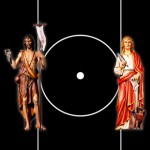
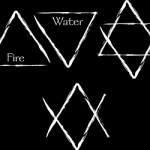
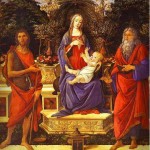
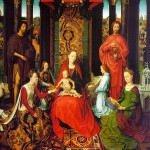
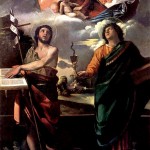
Was very informative and gives thought to the Symbolic meaning.
fraternal greeting to all Brethren
Very interesting side
Thanks for the classical paintings of the Sts. John. Very helpful.
Dedicating lodges to two “Saints John” was introduced into American ritual by Thomas Smith Webb, the author of the first American Masonic monitor. He took it from William Preston, the English ritualist who invented the idea in the late 1700s. If the two Saints John was ever adopted in English ritual, it did not last long, because, shortly after 1813, the United Grand Lodge of England began dedicating its lodges to King Solomon. So, the two Saints John remain today as an American innovation.
Throughout the 1700s, English ritual speaks only of “St. John” and a “Lodge of St. John,” with no clear indication as to which St. John was meant, although it is always assumed that it was St. John the Baptist. But, in the oral tradition of English Freemasonry, this St. John was always called “St. John of Jerusalem.” This term descended from the Order of Knights of the Hospital of St. John of Jerusalem, also known as the Knights Hospitaller, Knights of St. John, Knights of Rhodes, or Knights of Malta. which had its English Grand Priory at Clerkenwell, just outside London’s city gates.
From the 1600s, a time-immemorial lodge met at the St. John of Jerusalem Tavern in the Clerkenwell neighborhood. The lodge had a tradition of long-standing that its earliest roots had a connection with the old Clerkenwell Priory of the Order of the Hospital of St. John of Jerusalem. During the 1700s, that tradition became memorialized in Freemasonry in many references to “St. John of Jerusalem.” Lodges were named “St. John of Jerusalem,” although St. John the Baptist was never known by that name.
Today, craft lodges of the first three degrees are generally referred to as “St. John’s lodges.”
Pingback: St. John’s Day/Longest Day/Litha/Summer Solstice – PAGANISM RISING – Eye Opening Truth
Pingback: Masonic Notable Dates – Brothers Of Harmony Lodge #42
Pingback: Christmas and Freemasonry. | Freemason Information